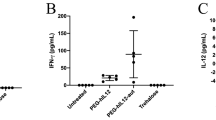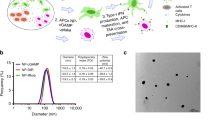Abstract
Polyethylenimine (PEI)–DNA complexes are nanoparticles that are able to efficiently transfer plasmids to the lungs. Interleukin-12 (IL12) gene transfer using PEI may represent an important strategy for lung cancer treatment. In this study, we evaluated the antitumoral efficacy of the administration of PEI–DNA nanoparticles carrying IL12 gene (PEI–IL12) for the treatment of lung cancer and pulmonary metastases in animal models. After inoculation of tumor cells, mice were treated intravenously with a single dose of PEI–IL12, PEI nanoparticles carrying the reporter gene β-galactosidase (PEI–LacZ) or vehicle. Transgene expression, survival rates and immune response were analyzed in both models. Administration of PEI–LacZ and PEI–IL12 nanoparticles controlled tumor growth and prolonged survival times in both animal models. Although PEI–IL12 and PEI–LacZ administration showed similar antitumoral effects in the lung cancer model, the efficacy of PEI–IL12 was significantly superior in the inhibition of the development of pulmonary metastases. Furthermore, the administration of PEI–DNA nanoparticles results in the production of high levels of proinflammatory cytokines. Our results showed that PEI–DNA nanoparticles are an efficient vector for mediating gene transfer to the lungs, are a potent inducer of the innate immune response and represents an interesting strategy for the treatment of bronchogenic carcinoma and metastatic lung carcinoma.
This is a preview of subscription content, access via your institution
Access options
Subscribe to this journal
Receive 12 print issues and online access
$259.00 per year
only $21.58 per issue
Buy this article
- Purchase on Springer Link
- Instant access to full article PDF
Prices may be subject to local taxes which are calculated during checkout






Similar content being viewed by others
References
Dubey S, Powell CA., Update in lung cancer 2007. Am J Respir Crit Care Med 2008; 177: 941–946.
Ries L, Melbert D, Krapcho M, Stinchcomb DG, Howlader N, Horner MJ . et al. SEER Cancer Statistics Review, 1975–2005. National Cancer Institute: Bethesda, MD, 2008.
Parkin DM, Bray FI, Devesa SS . Cancer burden in the year 2000. The global picture. Eur J Cancer 2001; 37 (Suppl 8): S4–66.
Trinchieri G . Interleukin-12 and the regulation of innate resistance and adaptive immunity. Nat Rev Immunol 2003; 3: 133–146.
Brunda MJ, Luistro L, Warrier RR, Wright RB, Hubbard BR, Murphy M et al. Antitumor and antimetastatic activity of interleukin 12 against murine tumors. J Exp Med 1993; 178: 1223–1230.
Cavallo F, Signorelli P, Giovarelli M, Musiani P, Modesti A, Brunda MJ et al. Antitumor efficacy of adenocarcinoma cells engineered to produce interleukin 12 (IL-12) or other cytokines compared with exogenous IL-12. J Natl Cancer Inst 1997; 89: 1049–1058.
Roy EJ, Gawlick U, Orr BA, Rund LA, Webb AG, Kranz DM . IL-12 treatment of endogenously arising murine brain tumors. J Immunol 2000; 165: 7293–7299.
Lenzi R, Edwards R, June C, Seiden MV, Garcia ME, Rosenblum M et al. Phase II study of intraperitoneal recombinant interleukin-12 (rhIL-12) in patients with peritoneal carcinomatosis (residual disease<1 cm) associated with ovarian cancer or primary peritoneal carcinoma. J Transl Med 2007; 5: 66.
Ansell SM, Geyer SM, Maurer MJ, Kurtin PJ, Micallef IN, Stella P et al. Randomized phase II study of interleukin-12 in combination with rituximab in previously treated non-Hodgkin's lymphoma patients. Clin Cancer Res 2006; 12 (20 Pt 1): 6056–6063.
Albelda SM . Gene therapy for lung cancer and mesothelioma. Chest 1997; 111 (6 Suppl): 144S–149S.
Frederiksen KS, Petri A, Abrahamsen N, Poulsen HS . Gene therapy for lung cancer. Lung Cancer 1999; 23: 191–207.
Duan X, Jia SF, Koshkina N, Kleinerman ES . Intranasal interleukin-12 gene therapy enhanced the activity of ifosfamide against osteosarcoma lung metastases. Cancer 2006; 106: 1382–1388.
Sangro B, Melero I, Qian C, Prieto J . Gene therapy of cancer based on interleukin 12. Curr Gene Ther 2005; 5: 573–581.
Holt GE, Disis ML . Immune modulation as a therapeutic strategy for non-small-cell lung cancer. Clin Lung Cancer 2008; 9 (Suppl 1): S13–S19.
Sterman DH, Recio A, Carroll RG, Gillespie CT, Haas A, Vachani A et al. A phase I clinical trial of single-dose intrapleural IFN-beta gene transfer for malignant pleural mesothelioma and metastatic pleural effusions: high rate of antitumor immune responses. Clin Cancer Res 2007; 13 (15 Pt 1): 4456–4466.
Tang MX, Szoka FC . The influence of polymer structure on the interactions of cationic polymers with DNA and morphology of the resulting complexes. Gene Ther 1997; 4: 823–832.
Goula D, Remy JS, Erbacher P, Wasowicz M, Levi G, Abdallah B et al. Size, diffusibility and transfection performance of linear PEI/DNA complexes in the mouse central nervous system. Gene Ther 1998; 5: 712–717.
Coll JL, Chollet P, Brambilla E, Desplanques D, Behr JP, Favrot M . In vivo delivery to tumors of DNA complexed with linear polyethylenimine. Hum Gene Ther 1999; 10: 1659–1666.
Poulain L, Ziller C, Muller CD, Erbacher P, Bettinger T, Rodier JF et al. Ovarian carcinoma cells are effectively transfected by polyethylenimine (PEI) derivatives. Cancer Gene Ther 2000; 7: 644–652.
Zou Y, Tornos C, Qiu X, Lia M, Perez-Soler R . p53 aerosol formulation with low toxicity and high efficiency for early lung cancer treatment. Clin Cancer Res 2007; 13: 4900–4908.
Ohana P, Gofrit O, Ayesh S, Al-Sharef W, Mizrahi A, Birman T et al. Regulatory sequences of the H19 gene in DNA based therapy of bladder cancer. Gene Ther Mol Biol 2004; 8: 181–192.
Ferrari S, Moro E, Pettenazzo A, Behr JP, Zacchello F, Scarpa M . ExGen 500 is an efficient vector for gene delivery to lung epithelial cells in vitro and in vivo. Gene Ther 1997; 4: 1100–1106.
Brattain MG, Strobel-Stevens J, Fine D, Webb M, Sarrif AM . Establishment of mouse colonic carcinoma cell lines with different metastatic properties. Cancer Res 1980; 40: 2142–2146.
Carvalho LH, Hafalla JC, Zavala F . ELISPOT assay to measure antigen-specific murine CD8(+) T cell responses. J Immunol Methods 2001; 252: 207–218.
Berraondo P, Crettaz J, Ochoa L, Pañeda A, Prieto J, Trocóniz IF et al. Intrahepatic injection of recombinant adeno-associated virus serotype 2 overcomes gender-related differences in liver transduction. Hum Gene Ther 2006; 17: 601–610.
Ramirez-Ortiz ZG, Specht CA, Wang JP, Lee CK, Bartholomeu DC, Gazzinelli RT et al. Toll-like receptor 9-dependent immune activation by unmethylated CpG motifs in Aspergillus fumigatus DNA. Infect Immun 2008; 76: 2123–2129.
Smyth MJ, Wallace ME, Nutt SL, Yagita H, Godfrey DI, Hayakawa Y . Sequential activation of NKT cells and NK cells provides effective innate immunotherapy of cancer. J Exp Med 2005; 201: 1973–1985.
Krieg AM . Direct immunologic activities of CpG DNA and implications for gene therapy. J Gene Med 1999; 1: 56–63.
Chace JH, Hooker NA, Mildenstein KL, Krieg AM, Cowdery JS . Bacterial DNA-induced NK cell IFN-gamma production is dependent on macrophage secretion of IL-12. Clin Immunol Immunopathol 1997; 84: 185–193.
Ballas ZK, Rasmussen WL, Krieg AM . Induction of NK activity in murine and human cells by CpG motifs in oligodeoxynucleotides and bacterial DNA. J Immunol 1996; 157: 1840–1845.
Stacey KJ, Sweet MJ, Hume DA . Macrophages ingest and are activated by bacterial DNA. J Immunol 1996; 157: 2116–2122.
Sparwasser T, Koch ES, Vabulas RM, Heeg K, Lipford GB, Ellwart JW et al. Bacterial DNA and immunostimulatory CpG oligonucleotides trigger maturation and activation of murine dendritic cells. Eur J Immunol 1998; 28: 2045–2054.
Cowdery JS, Chace JH, Yi AK, Krieg AM . Bacterial DNA induces NK cells to produce IFN-gamma in vivo and increases the toxicity of lipopolysaccharides. J Immunol 1996; 156: 4570–4575.
Roman M, Martin-Orozco E, Goodman JS, Nguyen MD, Sato Y, Ronaghy A et al. Immunostimulatory DNA sequences function as T helper-1-promoting adjuvants. Nat Med 1997; 3: 849–854.
Li S, Wu SP, Whitmore M, Loeffert EJ, Wang L, Watkins SC et al. Effect of immune response on gene transfer to the lung via systemic administration of cationic lipidic vectors. Am J Physiol 1999; 276 (5 Pt 1): L796–L804.
Tan Y, Li S, Pitt BR, Huang L . The inhibitory role of CpG immunostimulatory motifs in cationic lipid vector-mediated transgene expression in vivo. Hum Gene Ther 1999; 10: 2153–2161.
Qin L, Ding Y, Pahud DR, Chang E, Imperiale MJ, Bromberg JS . Promoter attenuation in gene therapy: interferon-gamma and tumor necrosis factor-alpha inhibit transgene expression. Hum Gene Ther 1997; 8: 2019–2029.
Dow SW, Elmslie RE, Fradkin LG, Liggitt DH, Heath TD, Willson AP et al. Intravenous cytokine gene delivery by lipid-DNA complexes controls the growth of established lung metastases. Hum Gene Ther 1999; 10: 2961–2972.
Whitmore MM, Li S, Falo Jr L, Huang L . Systemic administration of LPD prepared with CpG oligonucleotides inhibits the growth of established pulmonary metastases by stimulating innate and acquired antitumor immune responses. Cancer Immunol Immunother 2001; 50: 503–514.
Whitmore M, Li S, Huang L . LPD lipopolyplex initiates a potent cytokine response and inhibits tumor growth. Gene Ther 1999; 6: 1867–1875.
Yoshizawa H, Kagamu H, Gejyo F . Cancer immunogene therapy. Arch Immunol Ther Exp (Warsz) 2001; 49: 337–343.
Garzon MR, Berraondo P, Crettaz J, Ochoa L, Vera M, Lasarte JJ et al. Induction of gp120-specific protective immune responses by genetic vaccination with linear polyethylenimine-plasmid complex. Vaccine 2005; 23: 1384–1392.
Tirapu I, Arina A, Mazzolini G, Duarte M, Alfaro C, Feijoo E et al. Improving efficacy of interleukin-12-transfected dendritic cells injected into murine colon cancer with anti-CD137 monoclonal antibodies and alloantigens. Int J Cancer 2004; 110: 51–60.
Acknowledgements
The authors thank Cristina Olague and Africa Vales for their technical support. We thank CIFA staff for animal care. Supported in part by grants of the UTE project CIMA, Instituto Salud Carlos III C03/02, SAF 2006-03623 (Ministerio Educación y Ciencia) to G. G-A, J.C. P. B. and by Department of Education and Culture of the Government of Navarra (IIQ4273). M.R.G. is a recipient of a ‘Fundación Echebano’ fellowship. PB is a recipient of a ‘Juan de la Cierva’ contract.
Author information
Authors and Affiliations
Corresponding author
Additional information
Supplementary Information accompanies the paper on Cancer Gene Therapy website (http://www.nature.com/cgt)
Supplementary information
Rights and permissions
About this article
Cite this article
Rodrigo-Garzón, M., Berraondo, P., Ochoa, L. et al. Antitumoral efficacy of DNA nanoparticles in murine models of lung cancer and pulmonary metastasis. Cancer Gene Ther 17, 20–27 (2010). https://doi.org/10.1038/cgt.2009.45
Received:
Revised:
Accepted:
Published:
Issue Date:
DOI: https://doi.org/10.1038/cgt.2009.45
Keywords
This article is cited by
-
Nanoparticle-mediated tumor cell expression of mIL-12 via systemic gene delivery treats syngeneic models of murine lung cancers
Scientific Reports (2021)
-
Cytokines in clinical cancer immunotherapy
British Journal of Cancer (2019)
-
Doxorubicin Hydrochloride Loaded Zymosan-Polyethylenimine Biopolymeric Nanoparticles for Dual ‘Chemoimmunotherapeutic’ Intervention in Breast Cancer
Pharmaceutical Research (2017)



